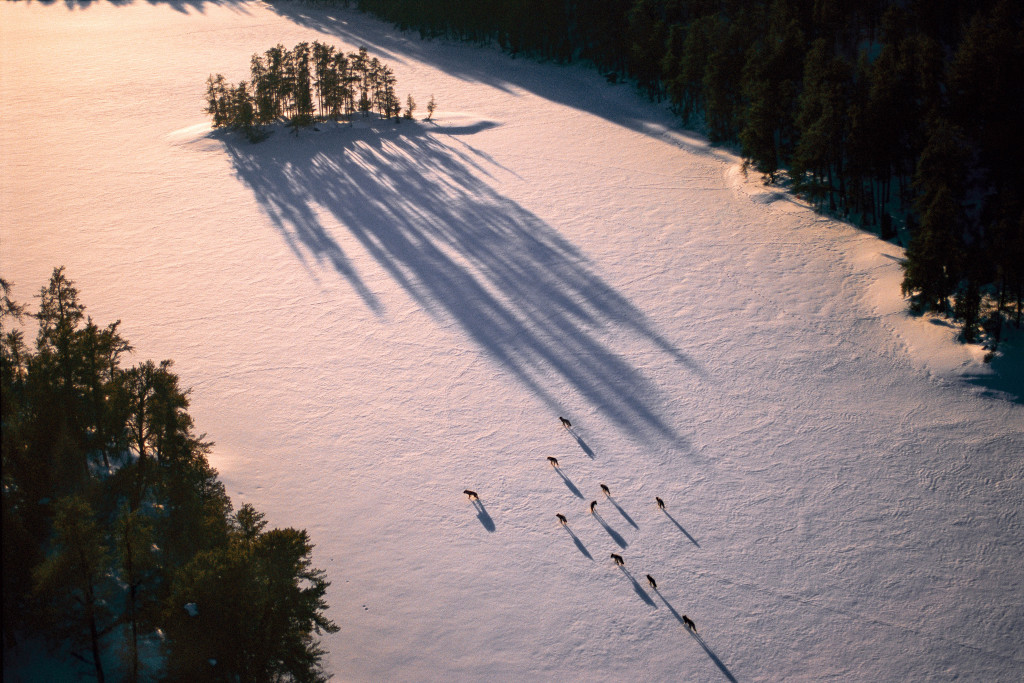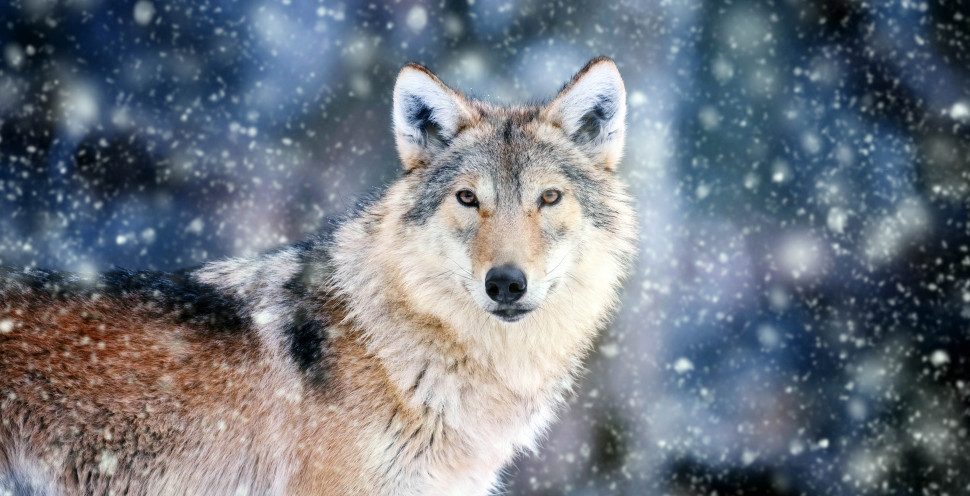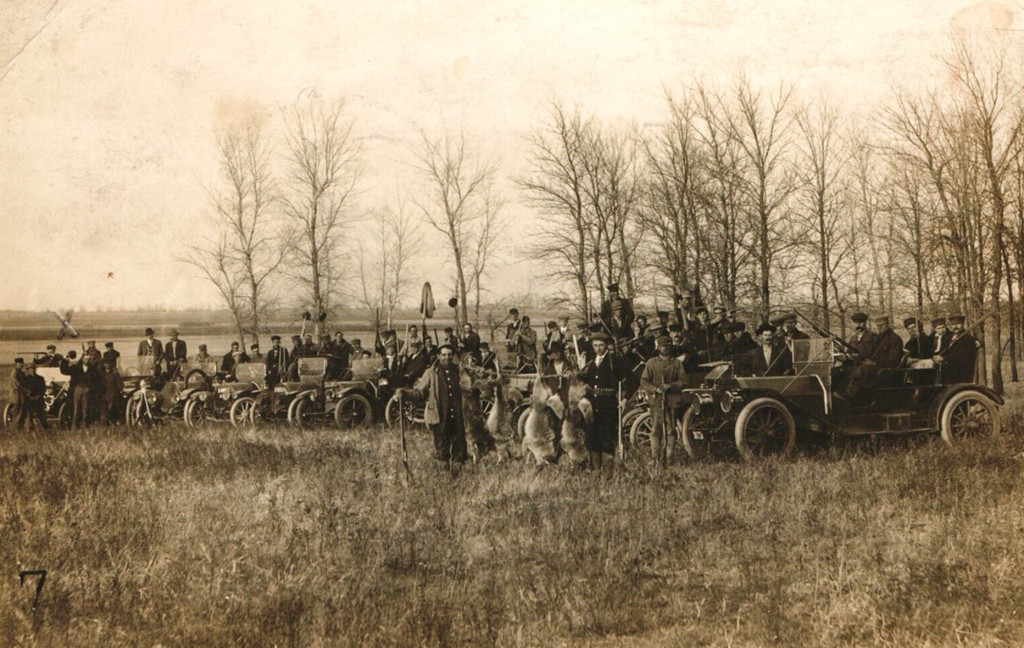
By Sam Wilson, Furbearer and Carnivore Program Manager, Nebraska Game and Parks Commission
The howls of wild wolf packs have been gone from Nebraska for more than 100 years, but recently a few dispersers walked hundreds of miles into the state to return to plains where the species was once common.
Few wild animals hold a larger place in cultures around the world than wolves. They are a symbol of the wild that has inspired legends, lore, fear, reverence, myths, fairy tales and books. They have been viewed as villains, heroes and partners throughout the ages. Societies have put forth great efforts to destroy or to restore this species.
When the first people arrived in North America, wolves were living in fierce competition with a large suite of predators including mountain lions, jaguars, brown and black bears, coyotes, and now-extinct animals like sabertoothed cats, giant short-faced bears, American lions and cheetahs, and their distant relative the dire wolf. By the time Europeans made their way to Nebraska, wolves were one of the few survivors flourishing on prairies grazed by the world’s greatest herds of large animals. Millions of bison roamed the plains before settlement along with vast herds of elk and pronghorn. And with these herds followed tens of thousands of wolves. They hunt in unison as a pack and were one of the most dominant forces on Nebraska’s prairies, following herds and defending kills from grizzlies — the other powerful predator of the time. This is the landscape that Meriwether Lewis and William Clark observed in 1804 when the men journeyed through Nebraska and other plains states.
Wolves are native to Nebraska and were a familiar sight to people here for thousands of years before William Clark documented the expedition’s first encounter with a wolf in Nebraska on July 20, 1804. On that day, he wrote in his journal that he killed an “emence [immense] large yellow Wolf” near the mouth of Weeping Water Creek in present day Otoe County.
Since that encounter, wolf populations were steadily reduced via elimination of their prey, including the great bison, elk and pronghorn herds. Settlers and explorers also killed wolves directly for pelts and to protect livestock at every opportunity. Bounties were paid for dead wolves, and hunting parties numbering in the hundreds pursued wolves, coyotes and other predators. They were trapped, shot and killed by poisoning until the last confirmed wolf in Nebraska was captured near Oconto in Custer County in 1913. This animal was mounted in the Hastings Museum in Hastings, Nebraska, and is still on display. Many reports of wild wolves occurred over the years since then, but none were confirmed until a wolf from the Great Lakes area was killed near Spaulding, Nebraska, in 2002.
Present Distribution and Dispersal to Nebraska
Gray wolves are the largest canid and had the widest historic distribution of all mammals other than humans, encompassing most of the northern hemisphere including almost all of North America, Europe and Asia. While they once flourished across most of North America, they are now mostly relegated to dense forests near the Great Lakes, the northern Rocky Mountains, northern California and the Pacific Northwest, Canada and Alaska.
Wolves are capable dispersers and may leave the area where they were born when they are 1–2 years old. They can walk hundreds of miles looking for new territories and mates. A recent example of this ability to roam was a wolf collared by Michigan Department of Natural Resources that walked more than 4,000 miles across Michigan, Wisconsin, Minnesota, North Dakota and then into Canada.
Mountain lions are the other native large predator that dispersed back into Nebraska over the past few decades. But differences in distances to their source populations make a similar comeback story for wolves much more difficult. Despite a similar ability for young animals of both species to disperse, wolves have a much longer path to find their way here. The population of mountain lions in the Black Hills of South Dakota is only about 30 miles from the Pine Ridge in Nebraska — where the first lion population formed. Wolves that disperse toward Nebraska from Wyoming would have to walk about 250 miles to reach our northwest corner, while wolves from the Great Lakes region would need to walk nearly 300 miles to reach the northeast corner. Either way, wolves have proven that they are very capable of covering this distance, but it is a still a rare occurrence.
Modern Confirmations in Nebraska
The Nebraska Game and Parks Commission has documented wild wolf presence in Nebraska on five occasions in modern times. This is not unique to Nebraska as all our neighboring states have also confirmed the presence of dispersing wolves. The five that made it to Nebraska were not collared or ear-tagged so determining their origin required genetic testing. Results of those tests show the Great Lakes population has been the source for all five.
That Great Lakes population is larger than the population in the northern Rockies and they are similar distances from Nebraska, so this result is not surprising. All five confirmations were made through wolves that had been killed. Nebraska Game and Parks Commission was able to obtain genetic samples from these animals to confirm their origin and determine that they were wild and not wolf/dog hybrid pets.
The first modern confirmation was a male wolf shot along the Boone County and Greeley County line in 2002. Then four more confirmations were made between 2020 and 2022: 1) a male in Rock County in November 2020, 2) a female in Dodge County in January 2021, 3) a male in Butler County in November 2021, and 4) a female in Custer County in January 2022. Despite these confirmations and possibly additional animals that have been to, or through, Nebraska but were not confirmed, there is no evidence of resident wolves or reproduction in Nebraska.
While the exact paths these animals walked is a mystery, it is remarkable when you imagine the journey they may have taken. Likely beginning in the north woods of Minnesota, Wisconsin, Michigan, or Canada (Great Lakes region) where their genetics suggest they were born. At some point they walked away from the pack that raised them. Heading south and west until forests gave way to pastures and corn fields in areas where there were no more wolves to encounter. Eventually they approached the Missouri River and likely dealt with it as they had most previous smaller rivers and streams, by simply swimming across as wolves are capable swimmers. They would have walked day after day for weeks or months to traverse hundreds of miles in unfamiliar territory, eaten deer, rabbits, mice, beavers, whatever they could find along the way, and eventually crossed into Nebraska from one of our neighboring states.
Present Status and Management for Wolves in Nebraska
Wild wolves that come to Nebraska are listed as federally endangered and are therefore protected under the authority of the U.S. Fish and Wildlife Service (Service). Gray wolves were previously taken off the Federal Endangered Species list on January 4, 2021, after the Service determined populations had been recovered. They were not protected for more than a year until federal protections were restored in Nebraska and 43 other states following a court order on February 10, 2022. Wolves may be killed only for the immediate protection of a person.
Management of wolves is fraught with challenges, even in western states with huge tracts of public lands. Nebraska is an agricultural state and the second largest cattle producer in the country. It is also more than 98% privately owned. Because of these factors, the Commission has no plans to reintroduce wolves to Nebraska. Any wolves that may enter from adjacent states or pass through Nebraska are currently federally protected. The Commission will work with the Service to monitor wolves and respond to any wolf-related conflicts that may occur.
If people have evidence of wild wolf presence in Nebraska, they should contact the U.S. Fish and Wildlife Service or the nearest Nebraska Game and Parks Commission office.

Biology
Adult gray wolves are larger than most common dog breeds, standing about 30 inches high at the shoulder and weighing 70-130 lbs. Despite the name “gray wolf,” early explorers in Nebraska described their fur color as gray, dusky, white, brown, black and yellow.
Wolves are predators that hunt cooperatively in a pack allowing them to focus on large herbivores like bison, elk, moose and white-tailed and mule deer. They are adaptable and will also feed on smaller animals, insects, plant matter and scavenge when needed. Unfortunately for livestock owners, and wolves themselves, they also sometimes depredate livestock. Wolves in North America are not typically a danger for people.
Wolves are intelligent, cunning and highly social. They hunt in packs averaging around eight wolves that consist of a dominant pair — which produces pups for the pack and may mate for life — and their subordinate offspring of various ages. It is essentially a family group guided by the older parents. The dominant female has one litter of four to eight young each year, often in a den dug into the soil. Older wild wolves may live eight or more years.

Wolf Bounties in Nebraska
“The larger number of claims coming into the [Nebraska] State Auditor’s office for bounties on wolves and coyotes has led that official to make an investigation,” said the New York Times on January 20, 1902, “and he has arrived at the conclusion that the farmers and ranchers in the western part of the State have gone into the business of breeding these animals for the bounty market. In one instance it was found that one farmer had raised more than 100 wolves last Summer from several animals he had trapped and penned up for that purpose.
“Other cases were unearthed where from fifty to sixty of these animals had been reared. In October and November they were killed and their scalps presented for redemption at the office of the County Clerk of each county. The State law authorized the County Clerk to pay $3 from the county fund for each coyote or wolf scalp presented, and he certifies the fact of payment to the Auditor, who pays $1 additional, making $4 for each wolf or coyote. The State Auditor declares that this pays better than hog raising, and naturally the farmers have turned their attention to this industry.
“The law was passed years ago when the wolf and coyote were great foes of the cattle and sheep men. In the last ten years $150,000 has been paid by the State alone as bounty. The Legislature of 1899 appropriated $60,000 for the purpose, and of this amount $43,000 was immediately demanded by holders of old claims. The remaining $15,000 was gone within six months, and when the last Legislature appropriated $15,000 it was at once swallowed up by holders of old claims.
“There are now on file with the Auditor claims aggregating $25,000, and by the end of next year this figure will be doubled. These figures indicate that instead of being killed off, the wolves are increasing. The explanation is now simple.”
A new wolf bounty law, sponsored by James A. Douglas of Rock County, took effect in 1905. It provided for a bounty of $5.00 for each wolf, $1.25 for each coyote, and $1.00 for each lynx killed.
The Lincoln Evening News of November 28, 1905, noted continuing problems with wolf bounty claims under the new law.
The News said: “Some of the state officials charged with supervision over the operations of the law are a little fearful that some of the county clerks are not well enough versed in animal lore to know the difference between the scalp of a yellow dog and that of a wolf, so that when John Jones comes in with a few bits of raw fur and ears attached they are apt to take the word of the claimant, as to the character of the creature from which the trophies were taken.”
– Courtesy of History Nebraska
